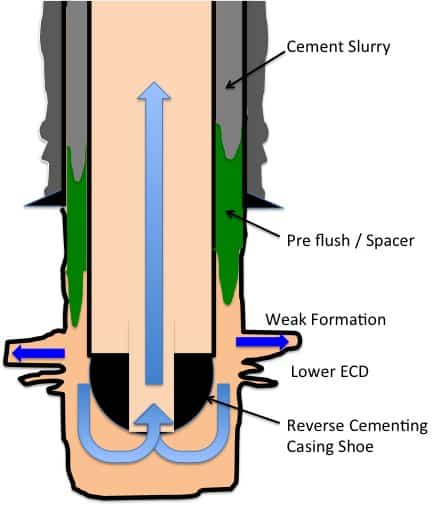I recently participated in a discussion about opting for the best alternative between conventional and reverse primary cementing to deal with  losses and frequent difficulties to reach the required TOC in an intermediate well section.
losses and frequent difficulties to reach the required TOC in an intermediate well section.
The interesting thing in this discussion was that the majority of the participants had no experience in doing reverse cementing. There were many arguments; most of then showing the expected resistance to do a new practice. It was then when I immediately recalled my first time. Yes, my first time with reverse cementing.
First reverse cementing job
I had absolutely no experience with reverse cementing at the time, and I wasn’t the only one. Nevertheless, the customer wanted to do it for the first time and wanted me, not so unexpected, to do it successfully!!
The idea of a plan was there, but I remember having more questions than answers. Not to mention, I didn’t have software capable of simulating reverse cementing or even an actual case history to look at. In essence, I was starting from a minimal background and, as you can imagine, with even less time to put a design together.
In essence, one of the disadvantages of conventional cementing is that as the cement rises in the annulus, there is an important increase in hydrostatic and friction pressure. This is not usually a problem, but in a losses situation, like any other, the cement always takes the path of minimum resistance. (Which is typically the losses zone). Hence, preventing its way up in the annulus. This can be simulated (predicted) by software, and there are several alternatives to ‘prevent’ or ‘mitigate’ the losses, yet we’re not always successful. Another option is Reverse Cementing, where the effect of friction pressure (and some hydrostatic) in the annulus can be removed, allowing us to fill it with cement from the top.
In conventional cementing, density and rheology need to be higher in displacing fluids to ensure cement coverage (channelling prevention). In reverse cementing, on the other hand, higher density and rheology in displacing fluids would likely have an adverse effect.
I Kept the pumping pressure in mind and was grateful for support from colleagues. I decided to propose that the cement slurry should only be 20% denser than the fluid in the well, and just slightly higher cement slurry rheology than the mud. (Previous jobs used conventional systems that were 90% denser than the mud – 1.9 sg). The job was performed operationally as planned, even without being able to simulate the job correctly and with a ‘hand’ estimated effect on ECD.
The result
The outcome, as seen with the sonic log, was not perfect. It was much better in terms of TOC than previous jobs done conventionally, most of them with losses during cementing.
Honestly, despite the results, I was not that happy, because the engineering was not that sound to my work standards. Sincerely, I felt a bit in the dark to adequately answer questions like; what to do to improve the results next time?
From my previous posts, you know that the thing I enjoy more about simulation is the capacity to truly affect the outcome. However, with no proper reverse cementing computer model, I feared that only educated trial and error, supported by cement log evaluation, was possible.
The next time, with a combination of products and software, we proposed the job conventionally. To be honest, the first time loses still happened but we almost reached the TOC. Nevertheless, the ‘conventional cementing solution’ sustained. In later attempts, the results improved, leaving the reverse cementing case only as a viable (not the preferred) alternative.
So, What is your experience with reverse cementing? Can you share?
Cheers
L. Diaz


Tried reverse cementing and I agree that it is not easy to plan.
Reverse cementing was done twice:
1) a losses secenario
2) A remedial job
Both of the jobs had challenges due to weak and over pressured formations. Losses and Inflow at the same time.
For the jobs, a sufficient large volume of spacer was used to ensure sufficient buffer between the wellbore fluid and cement slurry.
Apart from larger volumes, LCM was pumped in the annulus before the spacer.
For the remedial job, cement coverage was required around the liner, so modified fluid loss cell was used to see if the rheology and psd was optimum for the cement to move through the annular space.
Challenges:
Defining a fix pumprate. Focused on maintaining a constant pressure on surface (in side casing/tubing).
Use of a scavenger slurry between the spacer and slurry to minimise the poor mud removal.
Thickening time of the slurries.
Latex vs Particulate system for gas-right slurry.
Thanks Hassan for your excellent comment.
You have mentioned a key aspect of this type of operations, and that is the flow through narrow annular space and to minimize the slurry becoming a porous media on itself.
Once again thanks for your contribution
Hi,
Cementing long Casings strings in some complicated wells, consisted in pumping enough cement to “tie the shoe track” followed by pumping a top down squeeze in the annular.
The top down squeeze objective was to “seal” the annular from surface….Without noticing at first instance,was a squeeze… But, changing the point of view, resulted as a Reverse cementing operation, at least, partially.
This topic started to take high importance: it was a recurrent contingency that turned out to a frequent practice, so, our client needed it to be optimized in terms of volume, woc (rig time) and of course money.
We have seen that (without a real simulation computing) short volumes or too much displacement with OBM tremendously affected the outcome (the job presented Sustained casing pressure immediately) resulting in a repeated operation and of course NPT for everybody.
We did some arrangements, including adding some centralizers, long cement columns, pumping through independent lines from surface and avoiding displacing too much from surface, and a short thickening time, high rheology slurry.
The qualification for these operations consisted of:
-No Sustained Casing pressures
-Positive Pressure test against cement
-Monitoring along drilling and during completion
One last action consisted of improving the slurry quality in terms of additives addition (According to job objective). This can add some extra cost to client, but, comparing against a repeated operation… well, this perhaps worth the money.
Thanks for your comment Aaron. Very interesting and it also highlights what Bikouyi is referring: Planing is key
Hi Lenin,
This is a very interesting topic. This Technique is increasing in popularity as an alternative when facing issues such as lost circulation as you mentioned above.
I have to admit that I don’t have experience in the topic, however, I remember having lost circulation issues and this alternative was put on the table. We did not do the Job but I remember that I went through two interesting articles (SPE # below) on the Topic. Both helped me to understand some challenge but in all cases one the key factor for the success is a good planning of the job (rig up, float equipment, log to evaluate the cement etc…).
To be honest, I should say that despite all that, one of my concerns remains: Mud removal problem, which is not easy to address in this technique.
Here are the articles, they can be helpful for a reader (probably you already have them):
1. SPE 154564 – Unconventional Cementing method enables drilling in lost circulation zones: Case History
2. IADC/SPE 87197 – Reverse Circulation of Primary cementing Jobs – Evaluation and case history.